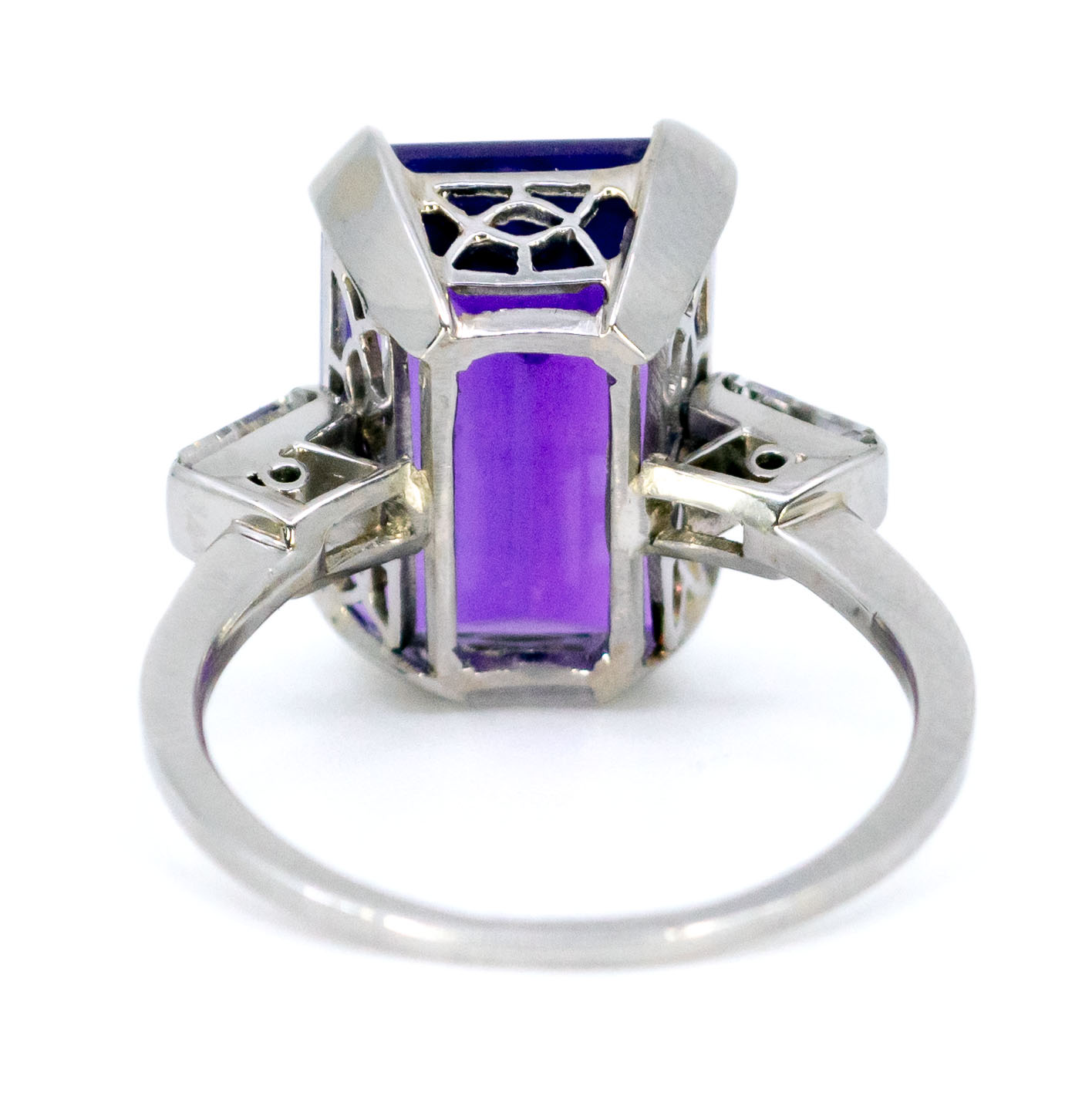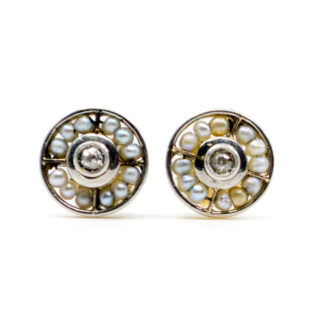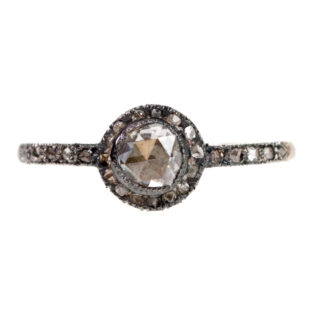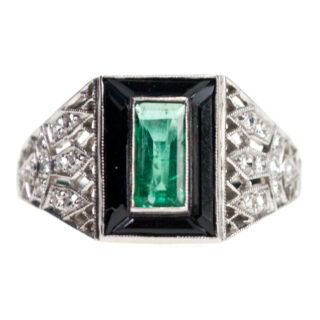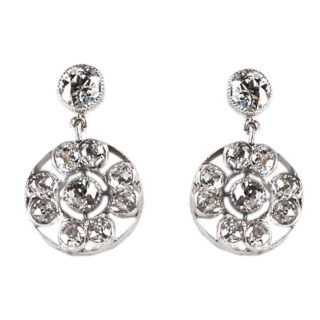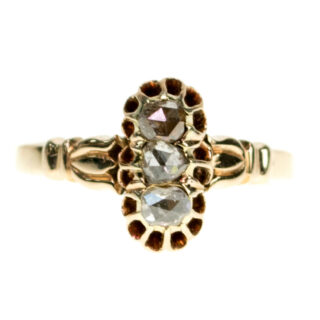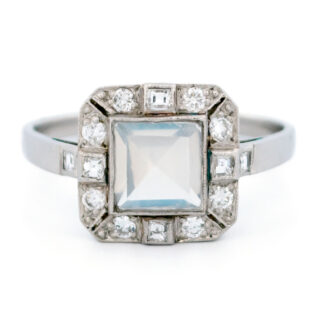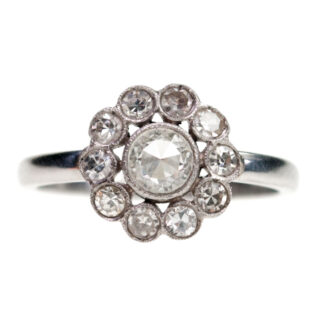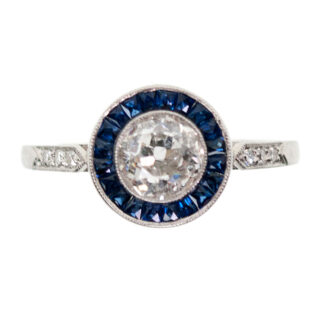This beautiful vintage Art Deco ring has an amethyst as the centerpiece, weighing approximately 7.00 carats. The amethyst is adorned with baguette cut diamonds that weigh approximately 0.30 carats (with an H SI1 grade), and the entire piece is made from platinum.
Details: ±7.00ct amethyst, ±0.30ct (H SI1) Baguette-cut diamonds, Platinum Ring.
Design Era: Vintage Art Deco.
Size: 16.71 NL / 52.5 FR / 6¼ US / M UK, sizeable (Within reason. Contact seller for information).
Dimensions: H 0.7 x W 1 x L 1.4 cm..
Weight in grams: 5,15.
Condition: Excellent condition – barely used with minimal signs of wear.
Shipping and Pickup: This stunning piece ships from our store located in the center of Amsterdam, The Netherlands. We offer both registered shipping and local pickup at our store. In the case of local pickup, any applicable shipping costs will be refunded.
About Us: Add some sparkle to your style with Binenbaum.com. We offer a stunning selection of antique and vintage jewelry that you won’t find anywhere else. From timeless rings and dazzling necklaces to unique brooches, we have something for every taste and occasion. Visit our website today and treat yourself to a piece of history.
| Design Era | |
|---|---|
| Design & Historical Context | Art Deco jewelry, also known as Jazz Age jewelry, became popular in the 1920s and remained in style through the 1930s. It was named after the Exposition International des Arts Décoratifs et Industriels Modernes, a exhibition held in Paris in 1925 that was largely dedicated to the jewelry arts. This style was inspired by a variety of cultural and artistic movements, such as Oriental, African, and South American art, as well as Cubism and Fauvism. Art Deco jewelry is known for its sharp, straight lines and emphasis on modernity and the machine age. During the Art Deco era, there were significant improvements in diamond cutting techniques, which made diamonds more radiant and sparkling than ever before. This, along with increased prosperity, allowed more people to afford diamond jewelry and engagement rings. Additionally, new casting techniques made it possible to produce more intricate and detailed settings. Art Deco jewelry was not only fashionable but also reflected the social and cultural changes of the time. The bold, modern design of Art Deco jewelry reflected the liberation and empowerment of women during the 1920s and 1930s. Today, Art Deco jewelry is highly sought after by collectors and is often featured in museum exhibitions and high-end auctions. |
| Key Materials | |
| Materials & Craftsmanship | amethyst Amethyst is a variety of quartz that is prized for its beautiful purple color. It is the birthstone for February and is often used in jewelry. The color of amethyst ranges from light to dark purple, and it can be found in various parts of the world, including Brazil, Uruguay, and Madagascar. Amethyst is a hard and durable gemstone, making it suitable for use in all types of jewelry. It is also believed to have certain healing properties and is often used in crystal healing practices. In ancient Greece, amethyst was thought to ward off drunkenness and is still believed by some to have sobering and calming effects. The color of amethyst is caused by impurities of iron and aluminum within the crystal. The deeper the color of the amethyst, the more valuable it is considered to be. Amethyst is often cut into faceted stones or shaped into cabochons for use in jewelry. It is also used in other decorative items such as figurines and vases. In addition to its beauty and healing properties, amethyst is also popular for its affordability compared to other precious gemstones. It is a popular choice for use in engagement and wedding rings, as well as other types of jewelry. Baguette-cut diamond The baguette diamond cut is a rectangular-shaped diamond cut that belongs to the group of step cuts. Step cuts, such as the baguette cut, are characterized by their parallel facets that are arranged in a terrace-like pattern. These facets are typically longer and narrower than those found on other diamond cuts, such as round or princess cuts. Baguette-cut diamonds typically have 14 facets, which are the flat faces or surfaces on a diamond that reflect light. These facets are arranged in a specific pattern to enhance the diamond's sparkle and brilliance. Baguette-cut diamonds are usually smaller in carat weight than other diamond cuts, as they tend to be cut into narrow, elongated shapes. Baguette-cut diamonds are often used as side stones in engagement rings, or as accents in other types of jewelry. They are known for their clean, modern lines and their ability to add a touch of elegance to any piece. Overall, the baguette diamond cut is a popular choice for those who prefer a more rectangular shape and a sleek, minimalist look. Platinum Platinum is a white metallic element that is known for its strength, durability, and resistance to tarnish and corrosion. It belongs to a group of elements called the platinum group metals, which also includes osmium, iridium, palladium, rhodium, and ruthenium. Platinum is often found in nature as an alloy, which is a mixture of two or more elements. It can be mixed with other platinum group metals or with other elements such as copper, nickel, or cobalt. It wasn't until 1804 that all of the elements in the platinum group were isolated and named, with the exception of osmium, which was not isolated until 1841. Platinum is a highly prized metal that is often used in the manufacture of fine jewelry. It is malleable, meaning that it can be easily molded and shaped, and it is ductile, meaning that it can be drawn into thin wires or sheets. It is also very strong, which makes it suitable for use in a wide range of applications. Platinum is named after the Spanish word "platina," which means "little silver." It is thought to have been named this because of its white metallic luster, which is similar to that of silver. Platinum was first discovered by the Spanish conquistadors in South America, near the Pinto River in present-day Columbia. |
| Size | |
| Dimensions | H 0.7 x W 1 x L 1.4 cm. |
| Gender | |
| Weight (in grams) | 5,15 |
| Condition | Excellent condition – barely used with minimal signs of wear |
Enhance the Beauty of Your Jewelry with Proper Care
Wearing your jewelry is a special way to express yourself and add a touch of personal style to any look. However, to ensure your jewelry remains in pristine condition, there are a few simple steps you need to take to keep it looking its best.
General Care Instructions:
Remove jewelry when showering or bathing, especially when at the beach, in the sea or in chlorinated water.
Avoid wearing jewelry while doing physical work such as housekeeping, gardening or exercise.
Storing your jewelry in a dry and cool place will help protect it from moisture, dirt and dust.
Keeping it away from harsh chemicals such as bleach, ammonia and chlorine will help to avoid discoloration and damage.
Cleaning your jewelry regularly with a soft cloth will help to keep it looking shiny and new.
Avoid exposing your jewelry to extreme temperatures, such as leaving it in direct sunlight or near a heater, as this can cause damage.
Handle your jewelry carefully and avoid dropping it, as this can cause the stones to loosen or the metals to scratch.
Finally, if possible, have your jewelry professionally checked and serviced. This will ensure that any potential problems are spotted and fixed before they become worse.
By following these tips, you can enjoy your precious jewelry for many years to come.
Related products
-
Diamond Pearl 18k Cluster Earrings 8277-1998
€ 695,00 VAT incl. (where applicable) -
Diamond 14k Silver Antique Ring 7311-0718
€ 1.695,00Original price was: € 1.695,00.€ 1.495,00Current price is: € 1.495,00. VAT incl. (where applicable) -
Diamond Emerald Onyx Platinum Deco Ring 7339-4900
€ 3.895,00 VAT incl. (where applicable) -
Diamond Platinum Pendant Earrings 5846-0616
€ 3.595,00 VAT incl. (where applicable) -
Diamond 14k Vertical Trilogy Ring 8259-1984
€ 1.395,00 VAT incl. (where applicable) -
Moonstone Diamond Platinum Square-Shape Ring 4489-4682
€ 2.995,00 VAT incl. (where applicable) -
Diamond Platinum Cluster Ring 4985-4693
€ 2.695,00 VAT incl. (where applicable) -
Diamond Sapphire Platinum Target Ring 6961-4858
€ 3.995,00 VAT incl. (where applicable)
- Home
- Collection
- Fine Jewelry
- Silver Jewelry
- Silverware
- Boxes
- Candlesticks
- Salt and pepper shakers
- Miniatures
- Salt cellars
- Spoon Set
- Condiments
- Frames
- Napkin Ring
- Spoon
- Oddities
- Cups
- Vases
- Cutlery
- Serving Spoon And Cake Server
- Candlesticks
- Baskets
- Hanukkiah
- Spice Tower
- Yad
- Tea Set
- Sugar Castor
- Napkin Rings
- Wine Bottle Coaster
- Wine Stopper
- Tea Pot
- Jugs
- Rattles
- Hip Flask
- Miscellaneous
- Rings 💍
- About
- Contact



